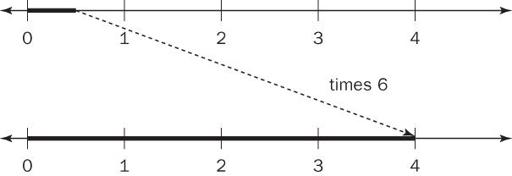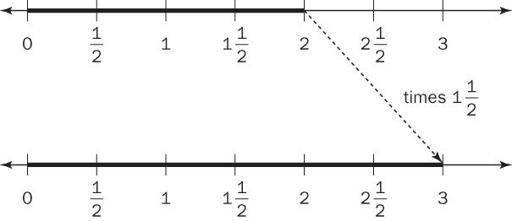Teaching the Common Core Math Standards With Hands-On Activities, Grades 3-5 (75 page)
Read Teaching the Common Core Math Standards With Hands-On Activities, Grades 3-5 Online
Authors: Judith A. Muschla,Gary Robert Muschla,Erin Muschla-Berry
Tags: #Education, #Teaching Methods & Materials, #Mathematics, #General

BOOK: Teaching the Common Core Math Standards With Hands-On Activities, Grades 3-5
12.28Mb size Format: txt, pdf, ePub
Working in groups, students will use a line segment to show an interpretation of scaling for multiplication.
Materials
Rulers; crayons; colored pencils; unlined paper for each group.
Procedure
1.
Explain that although multiplication is often thought of as a process of repeated addition of the same number, a better way to think of multiplication is as a process of scaling, or resizing.
2.
Explain the example and illustration of multiplying the whole numbers provided in the Background. Emphasize that multiplication in this case can be thought of as stretching a length of 4 units 3 times. This “stretching” is in fact resizing the original number. Once the 4-unit length is stretched 3 times, its length is 12 units. Note that the product is larger than the original number.
3.
Now explain the example and illustration of multiplying the whole number and the fraction. Emphasize that when multiplying a number by a fraction less than 1, the product is less than the original number. Multiplyingresults in a product of 2.
4.
Explain to your students that they are now to interpret multiplication as scaling. Present these two problems:
5.
Suggest that students draw number lines divided into the number of equal units represented by the denominators of the fractions. They should use the number lines to interpret scaling of multiplication in a fashion similar to the examples you provided. They might prefer to use colors to highlight the resizing of numbers.
6.
After completing their number lines and scaling, students should solve the problems by standard multiplication and compare their answers to the answers they found on their number lines.
Closure
Instruct groups to write an exit ticket explaining why multiplying a given number by a fraction greater than 1 results in a product greater than the given number; and why multiplying a given number by a fraction less than 1 results in a product less than the given number.
Answers
Number lines may vary but should be similar to the following:
(1)
(2)
Number and Operations—Fractions: 5.NF.6
“Apply and extend previous understandings of multiplication and division to multiply and divide fractions.”
6. “Solve real-world problems involving multiplication of fractions and mixed numbers, e.g., by using visual fraction models or equations to represent the problem.”
Background
Equations and models can help students understand and visualize mathematical processes. This is particularly true for multiplying fractions and mixed numbers.
Activity: Expanding a Recipe
Working in pairs or groups of three, students will solve problems involving a recipe by multiplying fractions and mixed numbers. They will write equations and create models to represent the problems.
Materials
Rulers; crayons; colored pencils; graph paper; reproducible, “Mandi's Party Punch,” for each pair or group of students.
Procedure
1.
Hand out copies of the reproducible to your students. Read the opening and instructions, then do the first problem together as a class. Emphasize that to make sure she has enough punch for all her guests, Mandi wants to increase the amount of each ingredienttimes.
2.
Ask your students how they would increase the amount of sugartimes. They should realize that they would multiply
to find
cups.
3.
Ask for volunteers to provide an equation to solve the problem.cups.
Other books
1 State of Grace by John Phythyon
The Grass Crown by Colleen McCullough
Far After Gold by Jen Black
Kissing Kin by Elswyth Thane
On the Move by Pamela Britton
The Yada Yada Prayer Group Gets Caught by Neta Jackson
Dalakis Passion 2 - Lucian's Delight by N.J. Walters
The Fox Cub Bold by Colin Dann
Leo Maddox by Darlington, Sarah




